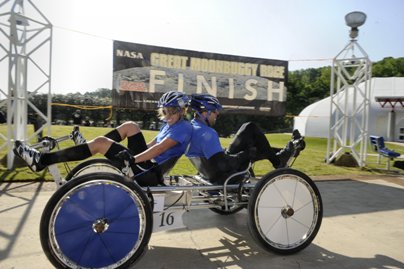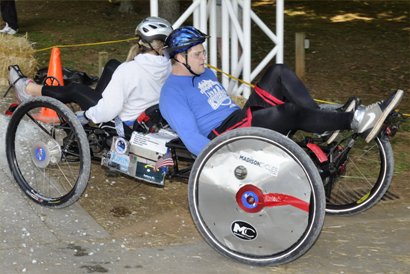HUNTSVILLE ALABAMA- Winning teams outraced more than 80 teams from 20 states, Puerto Rico, Canada, Germany, India, Italy, Russia and the United Arab Emirates. Approximately 600 student drivers, engineers and mechanics -- plus their team advisors and cheering sections -- gathered April 13-14 for the harrowing "space race."
Organized by NASA's Marshall Space Flight Center in Huntsville, the race challenges students to design, build and race lightweight, human-powered buggies. Traversing the grueling half-mile course, which simulates the cratered lunar surface, race teams face many of the same engineering challenges dealt with by Apollo-era lunar rover developers at the Marshall Center in the late 1960s. The winning teams post the fastest vehicle assembly and race times in their divisions, with the fewest on-course penalties.

The team from the University of Alabama in Huntsville took top prize in the college division of NASA's Great Moonbuggy Race with a time of 4 minutes and 3 seconds. (NASA/MSFC)
Race organizers presented both first-place winners with trophies depicting NASA's original lunar rover. NASA also gave plaques and certificates to every competing team. Sponsor Lockheed Martin Corp. of Huntsville presented the first-place high school and college teams with cash awards of $2,850 each. Individuals on the winning teams also received commemorative medals and other prizes.

Arab High School Team 1 from Arab, Ala., placed third in the high school division of the 19th annual NASA Great Moonbuggy Race with a time of 3 minutes and 30 seconds. (NASA/MSFC) America's space agency today crowned its vehicular engineering victors at the close of the 19th annual NASA Great Moonbuggy Race at the U.S. Space & Rocket Center in Huntsville, Ala. The team from Petra Mercado High School in Humacao, Puerto Rico won first place in the high school division; racers from the University of Alabama in Huntsville Team 1, claimed the college-division trophy.
The race is inspired by the original lunar rover, first piloted across the moon's surface in the early 1970s during the Apollo 15, 16 and 17 missions. Eight college teams participated in the first NASA Great Moonbuggy Race in 1994. The race was expanded in 1996 to include high school teams, and student participation has swelled each year since.
NASA's Great Moonbuggy Race has been hosted by the U.S. Space & Rocket Center since 1996. The race is sponsored by NASA's Human Exploration & Operations Mission Directorate in Washington. Major corporate sponsors are Lockheed Martin Corp., The Boeing Company, Northrop Grumman Corp. and Jacobs Engineering ESTS Group, all with operations in Huntsville. -NASA, For more information about the race, visit: Moonbuggy Race, Race Layout . For a complete list of additional awards for design, most improved and spirit, see Full list of awards (PDF).